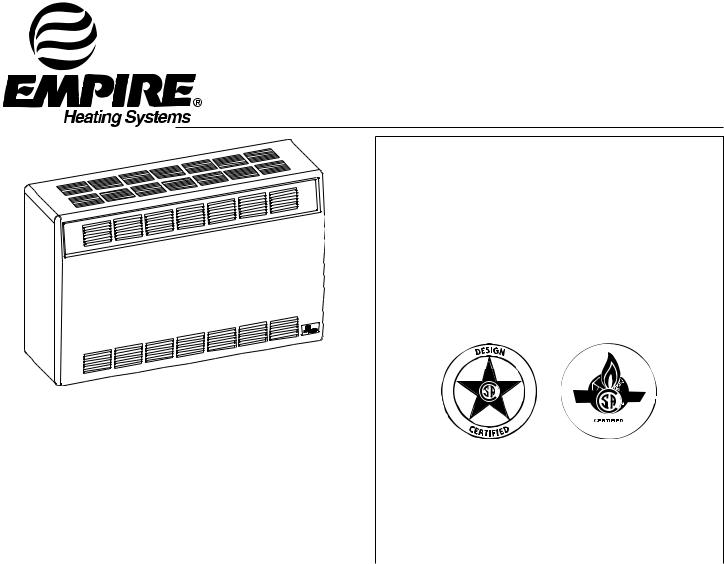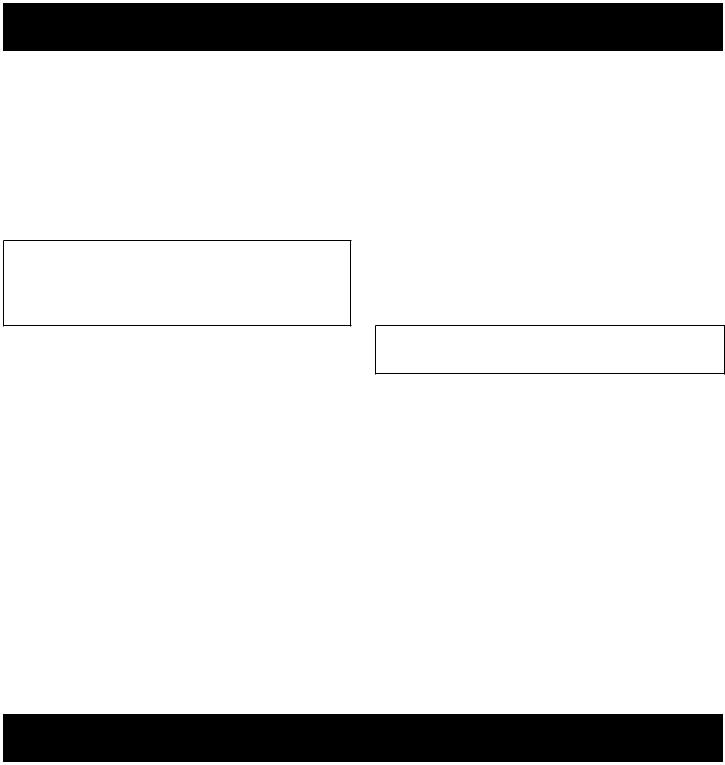Empire Comfort Systems DV-35-2SG User Manual

INSTALLATION INSTRUCTIONS
AND
OWNER'S MANUAL
DIRECT VENT
WALL FURNACE
MODELS
DV-25-2SG
DV-35-2SG
Installer: Leave this manual with the appli- |
|
|
|||
|
ance. |
|
EFFECTIVE DATE |
||
Consumer:Retain this manual for future refer- |
|
||||
|
JANUARY 2007 |
||||
|
ence. |
|
|||
|
|
|
|
|
|
|
|
|
|
||
|
|
|
|
|
|
|
WARNING: If the information in these instruc- |
|
|
|
|
|
|||||
|
tionsarenotfollowedexactly, afireorexplosion |
|
|
|
|
|
may result causing property damage, personal |
|
|
|
|
|
injury or loss of life. |
|
|
|
|
|
|
|
|
|
|
— Do not store or use gasoline or other flamma- |
|
|
|||
Thisappliancemaybeinstalledinanaftermarket, |
|||||
|
ble vapors and liquids in the vicinity of this or |
|
|||
|
|
permanently located, manufactured home (USA |
|||
|
any other appliance. |
|
|||
|
|
only) or mobile home, where not prohibited by |
|||
— WHAT TO DO IFYOU SMELL GAS |
|
||||
|
state or local codes. |
||||
|
• Do not try to light any appliance. |
|
This appliance is only for use with the type of gas |
||
|
• Do not touch any electrical switch; do not |
|
|||
|
|
indicated on the rating plate. This appliance is |
|||
|
use any phone in your building. |
|
|||
|
|
not convertible for use with other gases, unless a |
|||
|
• Immediately call your gas supplier from a |
|
|||
|
|
certified kit is used. |
|||
|
neighbor’s phone. Follow the gas suppli- |
|
|||
|
|
|
|||
|
er’s instructions. |
|
|
||
|
|||||
|
• If you cannot reach your gas supplier, call |
|
|
||
WARNING: If not installed, operated and |
|||||
|
the fire department. |
|
|||
|
|
maintainedinaccordancewiththemanufacturer's |
|||
— Installation and service must be performed by |
|
||||
|
instructions, this product could expose you to |
||||
|
a qualified installer, service agency or the gas |
|
substances in fuel or from fuel combustion which |
||
|
supplier. |
|
can cause death or serious illness. |
||
|
|
|
|
|
|
12434-9-0107 |
Page 1 |

TABLE OF CONTENTS |
|
SECTION |
PAGE |
Important Safety Information ...................................................................................................................... |
3 |
Safety Information for Users of LP Gas ...................................................................................................... |
4 |
Requirments for Massachusetts ................................................................................................................... |
5 |
Introduction.................................................................................................................................................. |
6 |
Specifications............................................................................................................................................... |
6 |
Gas Supply................................................................................................................................................... |
7 |
Clearances ................................................................................................................................................... |
8 |
Installation Instructions.......................................................................................................................... |
8-10 |
Thermostat Location.................................................................................................................................. |
10 |
Lighting Instructions ................................................................................................................................. |
11 |
Pilot Flame Characteristics ....................................................................................................................... |
12 |
Main Burner Flame Characteristics .......................................................................................................... |
12 |
Maintenance............................................................................................................................................... |
13 |
Troubleshooting......................................................................................................................................... |
13 |
How to Order Repair Parts......................................................................................................................... |
14 |
Parts List ................................................................................................................................................... |
14 |
Parts View.................................................................................................................................................. |
15 |
Optional Blower Installation Instructions ........................................................................................... |
16-17 |
Service Notes....................................................................................................................................... |
18-19 |
Page 2 |
12434-9-0107 |

IMPORTANT SAFETY INFORMATION
THIS IS A HEATING APPLIANCE
DO NOT OPERATE THIS APPLIANCE WITHOUT FRONT PANEL INSTALLED.
• Duetohightemperaturestheapplianceshouldbelocated |
circulating air passageways of the appliance be kept |
|
out of traffic and away from furniture and draperies. |
clean. |
|
• Children and adults should be alerted to the hazards of |
• DO NOT put anything around the furnace that will ob- |
|
highsurfacetemperaturesandshouldstayawaytoavoid |
struct the flow of combustion and ventilation air. |
|
burns or clothing ignition. |
• DO keep the appliance area clearand free from combus- |
|
|
||
• Youngchildrenshouldbecarefullysupervisedwhenthey |
tible material, gasoline and other flammable vapors and |
|
are in the same room as the appliance. |
liquids. |
|
• Clothingorotherflammablematerialshouldnotbeplaced |
• DO examine venting system periodically and replace |
|
on or near the appliance. |
damaged parts. |
|
• Anysafetyscreenorguardremovedforservicinganappli- |
• DO make a periodic visual check of pilot and burner. |
|
ance must be replaced prior to operating the appliance. |
Clean and replace damaged parts. |
|
• Keep burner and control compartment clean. |
• CAUTION: Pilot hole cover must be kept tightly closed |
|
• Vent cap hot while furnace is in operation. |
during operation. |
|
• DONOTusethisheaterifanyparthasbeenunderwater. |
||
• InstallationandrepairshouldbedonebyaQUALIFIED |
||
Immediately call a qualified service technician to inspect |
||
SERVICEPERSON. Theapplianceshouldbeinspected |
||
the heater and to replace any part of the control system |
||
before use and at least annually by a qualified service |
||
and any gas control which has been under water. |
||
person. More frequent cleaning may be required due to |
||
|
||
excessive lint from carpeting, bedding materials, etc. It |
|
|
is imperative that control compartments, burners and |
|
|
|
|
12434-9-0107 |
Page 3 |

SAFETY INFORMTAION FOR USERS OF LP-GAS
Propane (LP-Gas) is a flammable gas which can cause fires |
by point with the members of your household. Someday |
and explosions. In its natural state, propane is odorless and |
when there may not be a minute to lose, everyone's safety |
colorless.You may not know all the following safety precau- |
will depend on knowing exactly what to do. If, after read- |
tions which can protect both you and your family from an |
ing the following information, you feel you still need more |
accident. Read them carefully now, then review them point |
information, please contact your gas supplier. |
LP-GAS WARNING ODOR
If a gas leak happens, you should be able to smell the gas because of the odorant put in the LP-Gas.
That's your signal to go into immediate action!
• Do not operate electric switches, light matches, use your |
• Use your neighbor's phone and call a trained LP-Gas service |
phone. Do not do anything that could ignite the gas. |
person and the fire department. Even though you may not |
• Get everyone out of the building, vehicle, trailer, or area. Do |
continue to smell gas, do not turn on the gas again. Do not |
that IMMEDIATELY. |
re-enter the building, vehicle, trailer, or area. |
• Close all gas tank or cylinder supply valves. |
• Finally,lettheservicemanandfirefighterscheckforescaped |
• LP-Gas is heavier than air and may settle in low areas such |
gas. Have them air out the area before you return. Properly |
as basements. When you have reason to suspect a gas leak, |
trained LP-Gas service people should repair the leak, then |
keep out of basements and other low areas. Stay out until |
check and relight the gas appliance for you. |
firefighters declare them to be safe. |
|
NO ODOR DETECTED - ODOR FADE
Some people cannot smell well. Some people cannot smell the |
in LP-Gas also are subject to oxidation. This fading can occur if |
|
odor of the chemical put into the gas. You must find out if you |
there is rust inside the storage tank or in iron gas pipes. |
|
can smell the odorant in propane. Smoking can decrease your |
Theodorantinescapedgascanadsorborabsorbontoorintowalls, |
|
ability to smell. Being around an odor for a time can affect your |
||
masonry and other materials and fabrics in a room. That will take |
||
sensitivity or ability to detect that odor. Sometimes other odors |
||
some of the odorant out of the gas, reducing its odor intensity. |
||
in the area mask the gas odor. People may not smell the gas odor |
||
LP-Gas may stratify in a closed area, and the odor intensity could |
||
or their minds are on something else. Thinking about smelling a |
||
gas odor can make it easier to smell. |
vary at different levels. Since it is heavier than air, there may be |
|
The odorant in LP-gas is colorless, and it can fade under some |
more odor at lower levels.Always be sensitive to the slightest gas |
|
odor. If you detect any odor, treat it as a serious leak. Immediately |
||
circumstances. For example, if there is an underground leak, the |
||
go into action as instructed earlier. |
||
movement of the gas through soil can filter the odorant. Odorants |
||
|
SOME POINTS TO REMEMBER
• Learn to recognize the odor of LP-gas. Your local LP-Gas |
to set too long before refilling. Cylinders and tanks which |
|
Dealer can give you a "Scratch and Sniff" pamphlet. Use it |
have been out of service for a time may develop internal rust |
|
to find out what the propane odor smells like. If you suspect |
which will cause odor fade. If such conditions are suspected |
|
that your LP-Gas has a weak or abnormal odor, call your |
to exist, a periodic sniff test of the gas is advisable. If you |
|
LP-Gas Dealer. |
haveanyquestionaboutthegasodor,callyourLP-gasdealer. |
|
• If you are not qualified, do not light pilot lights, perform |
A periodic sniff test of the LP-gas is a good safety measure |
|
under any condition. |
||
service, or make adjustments to appliances on the LP-Gas |
||
|
||
system. If you are qualified, consciously think about the odor |
• If, at any time, you do not smell the LP-Gas odorant and you |
|
of LP-Gas prior to and while lighting pilot lights or perform- |
thinkyoushould,assumeyouhavealeak.Thentakethesame |
|
ing service or making adjustments. |
immediateactionrecommendedabovefortheoccasionwhen |
|
• Sometimes a basement or a closed-up house has a musty |
you do detect the odorized LP-Gas. |
|
|
||
smell that can cover up the LP-Gas odor. Do not try to light |
• If you experience a complete "gas out," (the container is un- |
|
pilot lights, perform service, or make adjustments in an area |
der no vapor pressure), turn the tank valve off immediately. |
|
where the conditions are such that you may not detect the |
If the container valve is left on, the container may draw in |
|
odor if there has been a leak of LP-Gas. |
some air through openings such as pilot light orifices. If this |
|
• Odor fade, due to oxidation by rust or adsorption on walls |
occurs, some new internal rusting could occur. If the valve is |
|
left open, then treat the container as a new tank. Always be |
||
of new cylinders and tanks, is possible. Therefore, people |
||
sure your container is under vapor pressure by turning it off |
||
should be particularly alert and careful when new tanks or |
||
at the container before it goes completely empty or having it |
||
cylinders are placed in service. Odor fade can occur in new |
||
refilled before it is completely empty. |
||
tanks, or reinstalled old tanks, if they are filled and allowed |
||
|
Page 4 |
12434-9-0107 |

REQUIREMENTS FOR MASSACHUSETTS
For all side wall horizontally vented gas fueled equipment installed in every dwelling, building or structure used in whole or in part for residential purposes, including those owned or operated by the Commonwealth and where the side wall exhaust vent termination is less than seven (7) feet above finished grade in the area of the venting, including but not limited to decks and porches, the following requirements shall be satisfied:
1.INSTALLATIONOFCARBONMONOXIDEDETECTORS.Atthetimeofinstallationofthesidewallhorizontal vented gas fueled equipment, the installing plumber or gasfittershallobservethatahardwiredcarbonmonoxide detectorwithanalarmandbatteryback-upisinstalledon the floor level where the gas equipment is to be installed. Inaddition,theinstallingplumberorgasfittershallobserve that a battery operated or hard wired carbon monoxide detector with an alarm is installed on each additional level of the dwelling, building or structure served by the side wall horizontal vented gas fueled equipment. It shallbetheresponsibilityofthepropertyownertosecure the services of qualified licensed professionals for the installation of hard wired carbon monoxide detectors
a.Intheeventthatthesidewallhorizontallyventedgas fueled equipment is installed in a crawl space or an attic, the hard wired carbon monoxide detector with alarm and battery back-up may be installed on the next adjacent floor level.
b.Intheeventthattherequirementsofthissubdivision can not be met at the time of completion of installation,theownershallhaveaperiodofthirty(30)days to comply with the above requirements; provided, however, that during said thirty (30) day period, a battery operated carbon monoxide detector with an alarm shall be installed.
2.APPROVED CARBON MONOXIDE DETECTORS. Eachcarbonmonoxidedetectorasrequiredinaccordance with the above provisions shall comply with NFPA 720 and be ANSI/UL 2034 listed and IAS certified.
3.SIGNAGE.Ametalorplasticidentificationplateshallbe permanently mounted to the exterior of the building at a minimum height of eight (8) feet above grade directly in line with the exhaust vent terminal for the horizontally vented gas fueled heating appliance or equipment. The sign shall read, in print size no less than one-half (1/2) inchinsize,“GASVENTDIRECTLYBELOW.KEEP
CLEAR OFALL OBSTRUCTIONS”.
4.INSPECTION. The state or local gas inspector of the side wall horizontally vented gas fueled equipment shall not approve the installation unless, upon inspection, the inspectorobservescarbonmonoxidedetectorsandsignage installed in accordance with the provisions of 248 CMR 5.08(2)(a) 1 through 4.
(b)EXEMPTIONS:Thefollowingequipmentisexempt from 248 CMR 5.08(2)(a)1 through 4:
1.The equipment listed in Chapter 10 entitled “Equipment Not Required To Be Vented” in the most current edition of NFPA 54 as adopted by the Board; and
2.ProductApproved side wall horizontally vented gas fueled equipment installed in a room or structureseparatefromthedwelling,buildingor structure used in whole or in part for residential purposes.
(c)MANUFACTURER REQUIREMENTS - GAS EQUIPMENT VENTING SYSTEM PROVIDED. When the manufacturer of Product Approved side wall horizontally vented gas equipment provides a ventingsystemdesignorventingsystemcomponents with the equipment, the instructions provided by the manufacturer for installation of the equipment and the venting system shall include:
1.Detailed instructions for the installation of the venting system design or the venting system components; and
2.Acompletepartslistfortheventingsystemdesign or venting system.
(e)Acopy of all installation instructions for all Product Approved side wall horizontally vented gas fueled equipment, all venting instructions, all parts lists for ventinginstructions,and/orallventingdesigninstructions shall remain with the appliance or equipment at the completion of the installation.
12434-9-0107 |
Page 5 |

INTRODUCTION
Introduction
Always consult your local Building Department regarding regulations, codes or ordinances which apply to the installation of a direct vent wall furnace.
Instructions to Installer
1.Installer must leave instruction manual with owner after installation.
2.Installer must have owner fill out and mail warranty card supplied with furnace.
3.Installer should show owner how to start and operate furnace and thermostat.
Warning:
Anychangetothisfurnaceoritscontrolcanbedangerous. This is a heating appliance and any panel, door or guard removed for servicing an appliance must be replaced prior to operating the appliance.
General Information
ThisfurnaceisdesigncertifiedinaccordancewithAmericanNational Standard/CSA Standard Z21.86 and CSA 2.32 by the Canadian StandardAssociation, as a Gravity Direct Vent Wall Furnace to be installed on an outside wall according to these instructions.
Any alteration of the original design, installed other than as shown in these instructions or use with a type of gas not shown on the ratingplateistheresponsibilityofthepersonandcompanymaking the change.
Important
All correspondence should refer to complete Model No., Serial No. and type of gas.
Notice: During initial firing of this unit, its paint will bake out and smokewilloccur. Topreventtriggeringofsmokealarms,ventilate the room in which the unit is installed.
Installation in Residential Garages
Gas utilization equipment in residential garages shall be installed so that all burners and burner ignition devices are located not less than 18" (457mm) above the floor.
Such equipment shall be located, or protected, so it is not subject to physical damage by a moving vehicle.
Qualified Installing Agency
Installationandreplacementofgaspiping,gasutilizationequipment or accessories and repair and servicing of equipment shall be performedonlybya qualifiedagency. Theterm"qualifiedagency" meansanyindividual,firm,corporationorcompanywhicheitherin person or through a representative is engaged in and is responsible for (a) the installation or replacement of gas piping or (b) the connection, installation, repair or servicing of equipment, who is experienced in such work, familiar with all precautions required and has complied with all the requirements of the authority having jurisdiction.
State of Massachusetts: The installation must be made by a licensed plumber or gas fitter in the Commonwealth of Massachusetts.
Theinstallationmustconformwithlocalcodesor,intheabsenceof
local codes, with the National Fuel Gas Code ANSI Z223.1/NFPA 54* Natural Gas and Propane Installation Code, CSA B149.1.
*Available from the American National Standards Institute, Inc., 11 West 42nd St., New York, NY 10036.
High Altitudes
For altitudes/elevations above 2,000 feet (610m), input ratings should be reduced at the rate of 4 percent for each 1,000 (305m) feet above sea level. Canadian HighAltitudes for locations having an elevation above mean sea level between 2,000 feet (610m) and 4,500 feet (1370m), the manifold pressure is to be decreased from 4.0"w.c.(.996kPa)to3.2"w.c.(.796kPa)forNaturalGasandfrom 10.0" w.c. (2.49kPa) to 8.0" w.c. (1.992kPa) for Propane Gas.
SPECIFICATIONS
Model |
DV-25 |
DV-35 |
Input BTU/HR (KW/H) |
25,000 (7.3) |
35,000 (10.3) |
Height |
27 3/4" (705mm) |
27 3/4" (705mm) |
Width |
37" (940mm) |
37" (940mm) |
Depth |
11 1/2" (292mm) |
11 1/2" (292mm) |
Gas Inlet (Pipe) |
1/2" (13mm) |
1/2" (13mm) |
Accessories for the Above Furnaces |
|
|
Blower Package |
DRB-1 |
DRB-1 |
Vinyl Siding Vent Kit |
DV-822 |
DV-822 |
Page 6 |
12434-9-0107 |
